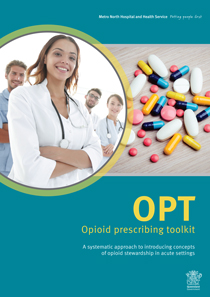Emergency Department Opioid
The ED-OPIOID study used quality improvement and evaluation methods to measure the success of a multifaceted oxycodone prescribing intervention and its impact on oxycodone prescribing for patients discharged home from the emergency department. The project aimed to reduce oxycodone prescribing, improve documentation, and ensure appropriate follow-up plans were in place.
Pain is a common symptom in patients presenting to ED, and is often the primary reason for patients seeking emergency medical attention. A 2016 audit of local prescribing (RBWH ED) revealed oxycodone was prescribed in approximately 5% (n=3,875/77,500) of patients discharged home from ED. In addition it showed that clinical documentation and discharge communication was poor.
The intervention consisted of staff education sessions, posters within the ED, and a patient information brochure. The intervention was introduced and led by a team within ED including the Director and senior clinicians in January 2017.
This project improved patient care by reducing inappropriate or unnecessary oxycodone prescribing and improving both patient education and the quality of medical handover to GPs. The overall number of oxycodone prescriptions remained stable throughout and after the intervention, but an effective decrease in the quantity of oxycodone tablets (see figure 2) written in each prescription occurred, significantly decreasing the duration of opioid treatment by (2-3 days). In addition, improved documentation surrounding oxycodone prescribing on discharge was observed.
Figure 2

Contact us
Phone: (07) 3333 3333
Email: email@health.qld.gov.au

